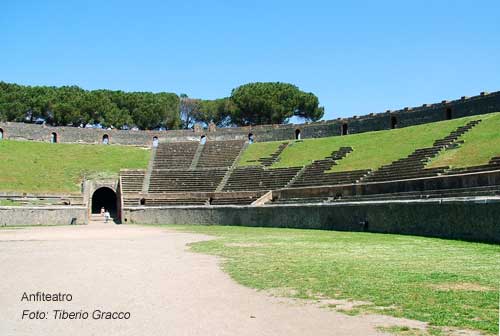
It is presumed that the amphitheatre in Pompeii, the oldest known to us, must have provided the basic model for the subsequent buildings. The form derives from the duplication of the structure of the theatre (amphitheatre means "double theatre" or "circular theatre"): it is an elliptical structure situated in a depression in the ground and backing onto embankments. It consists of a large cavea around which are the steps, divided into sections, which cover the entire perimeter of the construction. The various sections of the cavea - ima cavea (low part), media cavea, (middle part) and summa cavea (upper part) - were intended for the various social classes: the seats in the lower central area were reserved for dignitaries, while those high up were for the plebeians. It was furnished with accessways to the seats as well as with entrances to the cavea. The amphitheatres were sometimes equipped with a velarium (a large canopy which was stretched over the amphitheatre in case of rain) and, in the more developed types, with a system of canals and bulkheads which allowed the cavea to be flooded so that naval battles could be staged.
AMPHITHEATRE
This is an impressive and grandiose construction, capable of holding up to 12,000 spectators (others have calculated 20,000). It hosted all the circus shows and the gladiatorial games so dear to the Pompeians, who devoted most of their spare time to these performances. The period of its construction dates back to 80 B.C. (it was commissioned by the magistrates Quintus Valgus and Marcus Porciusl and is therefore one of the oldest buildings in existence, which leads to the inference that it might have represented a model for all those which were subsequently built in Rome. It was constructed in part by making use of an embankment, in part by digging down into the earth for several metres. The access steps are outside the building. The doors on the western side lead into the arena.
Unlike the other Roman amphitheatres, the one in Pompeii does not have an underground section. It was equipped with a velarium, that is a cover which was stretched over the complex in case of rain: the rings to which the canopy was fixed can still be seen.



